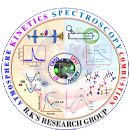Rate coefficients for reaction of the hydroxyl radical (OH) with three hydrofluorocarbons (HFCs) CF3CH2CH3, HFC-263fb, (k1); CF3CHFCH2F, HFC-245eb, (k2); and CHF2CHFCHF2, HFC-245ea, (k3); which are suggested as potential substitutes to chlorofluorocarbons (CFCs), were measured using pulsed laser photolysis−laser-induced fluorescence (PLP−LIF) between 235 and 375 K. The Arrhenius expressions obtained are k1(T) = (4.36 ± 0.72) × 10-12 exp[−(1290 ± 40)/T] cm3 molecule-1 s-1; k2(T) = (1.23 ± 0.18) × 10-12 exp[−(1250 ± 40)/T] cm3 molecule-1 s-1; k3(T) = (1.91 ± 0.42) × 10-12 exp[−(1375 ± 100)/T] cm3 molecule-1 s-1. The quoted uncertainties are 95% confidence limits and include estimated systematic errors. The present results are discussed and compared with rate coefficients available in the literature. Our results are also compared with those calculated using structure activity relationships (SAR) for fluorinated compounds. The IR absorption cross-sections at room temperature for these compounds were measured over the range of 500 to 4000 cm-1. The global warming potentials (GWPs) of CF3CH2CH3(HFC-263fb), CF3CHFCH2F(HFC-245eb), and CHF2CHFCHF2(HFC-245ea) were calculated to be 234, 962, and 723 for a 20-year horizon; 70, 286, and 215 for a 100-year horizon; and 22, 89, and 68 for a 500-year horizon; and the atmospheric lifetimes of these compounds are 0.8, 2.5, and 2.6 years, respectively. It is concluded that these compounds are acceptable substitutes for CFCs in terms of their impact on Earth's climate.
-
Call
-
E-mail
Journal Details
1. Rate Coefficients for the Reactions of OH with CF3CH2CH3 (HFC-263fb), CF3CHFCH2F (HFC-245eb), and CHF2CHFCHF2 (HFC-245ea) between 238 and 375 K..
B. Rajakumar, R. W. Portmann, James B. Burkholder, A. R. Ravishankara. J J. Phys. Chem., , 6724–6731, 110, 21
